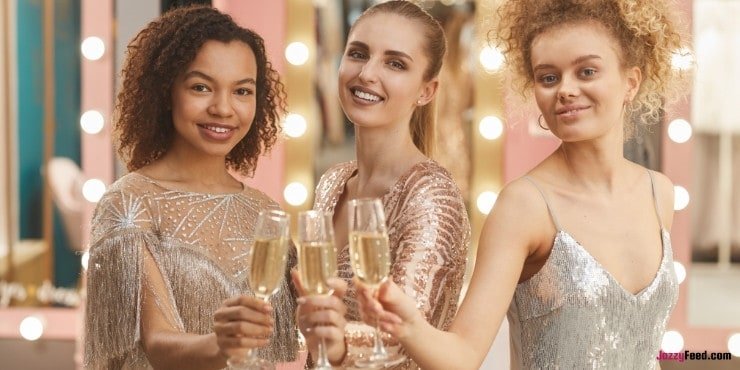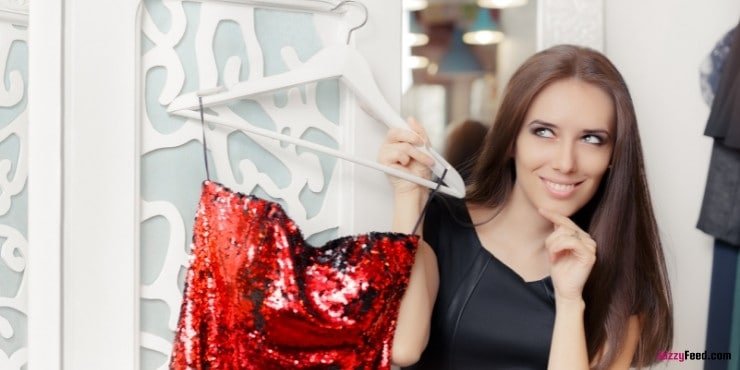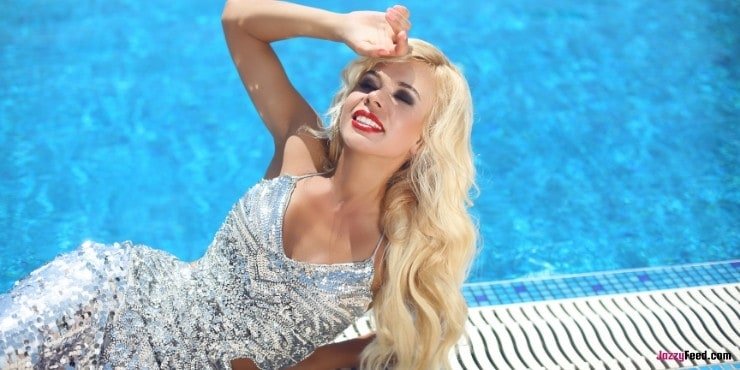Brocade is a fancy fabric, and you don’t have to be a fabric expert to recognize it. Brocade has a high-end look and feels to it, therefore brocade dress styles scream high-end fashion. You don’t have to be a Hollywood star to have a couple of favorite brocade gowns. If you do know how to wear brocade dress designs, though, you will undoubtedly seem like a celebrity whenever you put on one.

What is Brocade?
Brocade is commonly made from silk, cotton, polyester, and viscose. The raised design, which is commonly floral but can also be abstract or geometric, creates the brocade design. This is a thick fabric that can be found in both high fashion and household textiles.
A jacquard attachment is used to create the distinguishing pattern on brocade cloth, which is created using a particular jacquard loom built specifically for this purpose. Individual warp threads may be controlled to an unbelievable degree on this type of loom. This is how brocade fabric’s raised design is made.

Brocade is commonly constructed with floral patterns, but it may also be made with animal motifs, scrollwork, and any other pattern you can think of. The weaving process allows for the creation of virtually any pattern. Brocade fabric is frequently produced using thread that is not the same color as the rest of the fabric. This draws attention to the weaving pattern’s exquisite design. Gold is a popular color for the pattern because it has a rich appearance and catches the light effectively, making the fabric’s lovely design stand out. The pattern is just on the front side of the cloth; it is not on the back.
Types of Brocade Dresses
There are numerous brocade dress styles to choose from, and the trend of wearing brocade cloth has only grown in popularity, not decreased. With a few exceptions, brocade fabric can be used to make almost any form of dress. Because brocade is a thicker fabric, some styles are simply not possible to create with it. To preserve their aesthetic, silky slip dresses, for example, must remain lightweight and satiny. Knit fabrics, which are not utilized in brocade, are used to make sweater dresses.

Brocade fabric, on the other hand, can be utilized to construct a wide range of dress styles and is frequently done so. Fit and flare styles, for example, are very popular in cocktail gowns. Professional aesthetics, such as sheath dresses, can be achieved with it. Brocade, on the other hand, is most typically seen in evening attire due to its elegance. This is a common choice for ball gowns and other formal attire.
Any design can be made to look like a brocade dress. Extras and embellishments, such as sequins, lace, or fur trim, may be included. Some dresses may even be embellished with crystals for added glitter.
Cocktail Brocade Dress

Fit and Flair Brocade Dress

Mermaid Brocade Dress

Traditional Chinese Brocade Dress

Vintage Brocade Dress

Types of Brocade Fabric
Brocade comes in a variety of styles, each with its own set of characteristics. Brocade is made up of a variety of fabrics and weaving processes that are used to produce certain patterns. Because of the elevated pattern, brocade is also known as embossed cloth.
Cotton
Cotton brocade is a type of brocade that is created from cotton cloth and is typically brocaded with cotton. In India, this type of brocade is quite popular. Balucar, himru, jamdani, and paithani are examples of cotton brocade fabrics.
Himru
Silk and cotton are used to make Himru brocade. This provides the fabric a cotton-like softness as well as the gloss and feel of silk.
Silk
Silk brocade is a lovely fabric that is silky smooth to the touch. Because the initial brocade textiles were always made of silk, this form of brocade is still considered traditional.
Synthetic
Synthetic brocade is made of synthetic textiles and is not a sort of faux brocade. Synthetic brocade is constructed of polyester or another synthetic fabric rather than a natural material such as cotton or silk.
Zari
Zari brocade is a gold and silver threaded brocade. Brocades are frequently constructed of silk or cotton cloth. The characteristic zari brocade motifs are made with very delicate silver wires and gold thread. This sort of brocade is ideal for a spectacular party dress.
FAQs – Brocade Dress
Are you still perplexed by brocade? How is it used, what does it do, and where can you find it in your own closet? There’s a lot to learn about brocade, as well as a lot of questions to ponder. We have the answers. We investigated the most common brocade queries and discovered everything you need to know about this magnificent vintage fabric style.
Is it possible to find vintage brocade dress styles?
Brocade is a fabric that stretches back hundreds of years and is frequently used in costumes. It was worn by queens and monarchs throughout history, as well as affluent and powerful people who wanted to flaunt their wealth. Brocade, on the other hand, has gotten increasingly inexpensive throughout the decades, allowing anyone to begin wearing it. Brocade dresses have been manufactured in almost every style over the years as a result. If you start hunting for old gowns, you might come across one made of brocade.
Brocade is a classic fabric that is still popular in vintage fashion. It’s used to construct current apparel with vintage designs, and if you look hard enough, you can find it in vintage and secondhand shops. Brocade has been a favorite formal wear fabric for years, and it has been utilized to create a wide range of design trends, which means there are many exquisite dresses produced from this material.
What is the best way to care for brocade fabric?
Because brocade can be fashioned from a variety of fabrics, there is no one set of instructions that will work for all brocade gowns. Look at the label on your brocade dress if you need to clean it. It’s critical to determine the fabric composition in order to determine whether or not you can wash a dress at home.
Brocade, on the other hand, is prone to shrinking when wet due to its intricate pattern. Even if you have a simple cotton brocade fabric, dry washing is the most common approach for cleaning it.
Hand washes a brocade dress in cold water if you’re going to do it yourself. If you twist or pull on the garment, you risk permanently damaging it.
Dry brocade items on a flat surface away from direct sunshine and heat. Drying a brocade dress is not a good idea. The cloth may be harmed as a result of this. You don’t want to put the dress away either. This can cause threads to break, resulting in pattern and garment damage.
What type of fabric is brocade?
With the appropriate needlework, almost any fabric may be turned into brocade cloth. Brocade is, after all, about the design, not the material. Brocade is made from a variety of materials, but not all of them are suitable for making brocade since the material must be strong and heavy enough to withstand the typical wear and tear. When it comes to dressmaking, cotton, sating, silk, velvet, and wool are the most popular materials used in brocade. There are also synthetic and twill blends, which are composites of more than one fiber.
How is brocade made?
Three threads are woven together to create brocade cloth. Before they are knitted, the three yarns are colored. The jacquard loom has become even more advanced in recent years. Patterns are now programmed onto automated looms, which then reproduce the pattern on cloth. China continues to be the world’s greatest manufacturer of brocade fabric, with Australia leading the way in wool brocade production. Brocade clothing and accessories may now be manufactured in any color or pattern, and you’ll see it in a variety of styles.
What does brocade fabric look like?
Brocade fabric is produced from a variety of materials and designs, but it retains its distinct appearance. Brocade has a subtle gloss to it, catching and reflecting light. It also features a detailed design that runs the length of the fabric. The pattern is elevated on the surface and woven into the fabric. This pattern is also a different color than the rest of the fabric, making it stand out even more. The colors are sometimes very contrasted, making the pattern very visible. The brocade design may be a comparable hue to the rest of the fabric in other types.
Brocade in silver or gold, on the other hand, is significantly more frequent and is a fairly typical aesthetic for this fabric. To give the material a truly royal appearance, early brocades were created with silver and gold.
What is the difference between jacquard, brocade, and damask fabrics?
All brocade fabric was handwoven or woven on a drawloom before the year 1801. Using a drawloom to create the elaborate design of brocade cloth was a demanding task that required at least two persons.
That year, Joseph Marie Jacquard invented the revolutionary Jacquard loom. This incredible artwork was printed on cards that replicated the patterns on the cloth. Best of all, this loom could be operated by just one person… even if they had no weaving experience. By the turn of the century, the loom had become so popular that other looms were obsolete.
Everything, not just brocade, was woven on the jacquard loom. Damask cloth was also made with it. Even though all three textiles are manufactured on the same sort of loom, there are unique and clear variances between jacquard, brocade, and damask fabrics. The jacquard loom can produce a wide range of fabric kinds. Jacquard, damask, and brocade are probably the most frequent fabrics found in garments.
The elevated design on the cloth is what distinguishes brocade from other fabrics. The word “embossed cloth” comes from an Italian word that means “embossed cloth.” Only one side of the brocade is embroidered.
Damask, on the other hand, can be worn both ways. The damask pattern is seen on both sides of the fabric. This is a woven pattern with complex flower and geometric motifs on it. It’s frequently created in rainbow patterns. Damask patterns, on the other hand, are frequently in the same color as the rest of the fabric, resulting in a tone-on-tone design rather than the contrasting thread seen in brocade.
Jacquard fabric can be any sort of fabric manufactured on a jacquard loom, but it’s most commonly used to describe jacquard knits with patterns knit right in. Socks with argyle and herringbone patterns are examples of this. It’s a typical jacquard fabric that’s highly stylized and manufactured with its own cool pattern if it’s not a brocade or a damask.
How does brocade fabric impact the environment?
Environmental concerns and the different industries that impact the world around us are becoming more widely recognized. Textile manufacturing has a harmful impact on the environment in many ways. So, how harmful is brocade for the environment’s health?
It all depends on the situation. Brocade has a wide range of environmental impacts because it may be constructed from so many different types of cloth. Brocade has an extremely low environmental impact when produced using silk, which is the most environmentally friendly fabric available. Pesticides, fertilizers, and chemicals are not used in the production of silk. Silkworms are gathered and processed naturally, with no hazardous poisons used in the process.
Cotton can be very sustainable, but how it is cultivated and harvested is crucial. Some farms utilize toxic chemicals, such as pesticides and fertilizer, to grow cotton, which harms the environment. Wool is also renewable, but only to a certain extent. Some procedures are significantly less sustainable than others since wool is obtained from animals. Wool is not healthy for the environment when it is collected through poor land usage and animal mistreatment.
When it comes to synthetic textiles, however, no type of brocade is worse for the environment than the others. Synthetics do not disintegrate naturally, contributing to the global plastics crisis. Synthetic fabric is also created using poisons and chemicals that harm not just the environment but also the people who work in the industry. When the cost of real silk is prohibitively high, recycled synthetics is a considerably better option.
Look for certification badges if you want to stick to brocade dresses that are created in more environmentally responsible ways. The Global Recycled Standard, Global Organic Textile Standard, and Silk Mark certifications all certify that the cloth you’re wearing is environmentally friendly and mindful.
What is brocade fabric used for?
Brocade cloth is often used for other garments besides dresses. Suits and pants, as well as jacket designs, are available. It’s also utilized in home textiles like drapes and furniture upholstery. You might even come upon a brocade accessory now and then. Separates, such as jacket patterns, skirt styles, and other apparel pieces, are also made from brocade. Brocade was originally very popular in tapestries, and it is still used for that purpose now, albeit tapestries aren’t as popular as they were.

